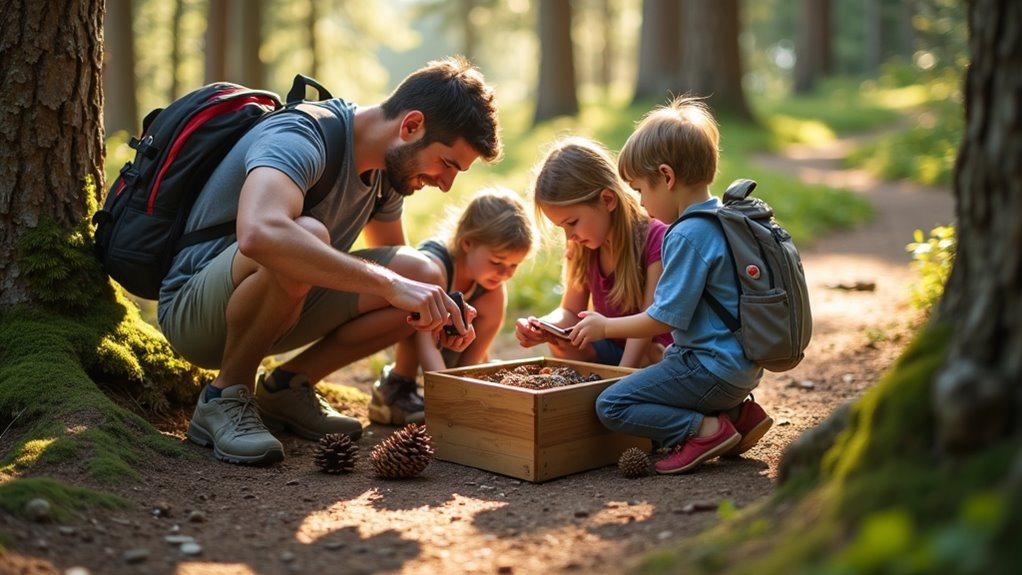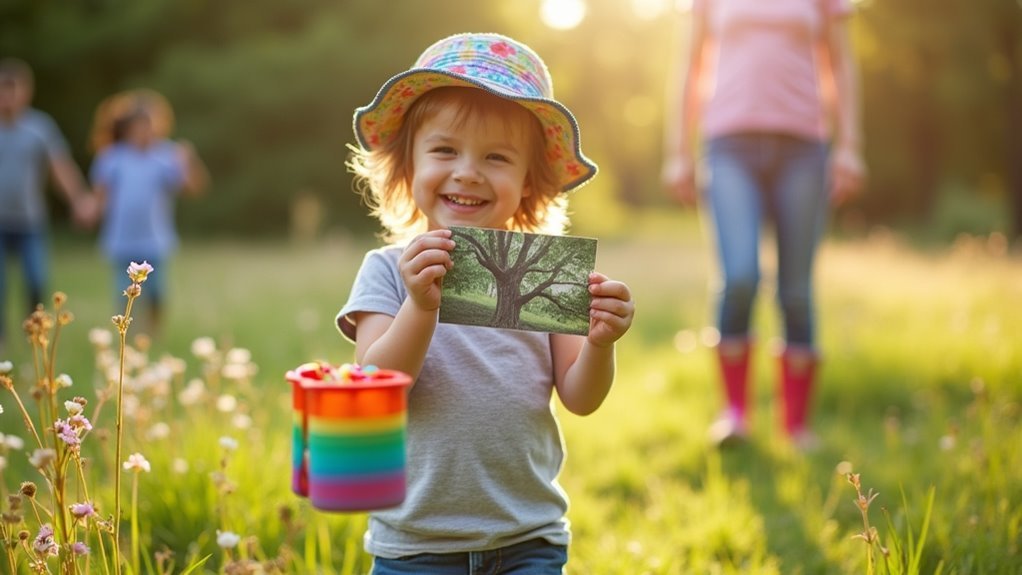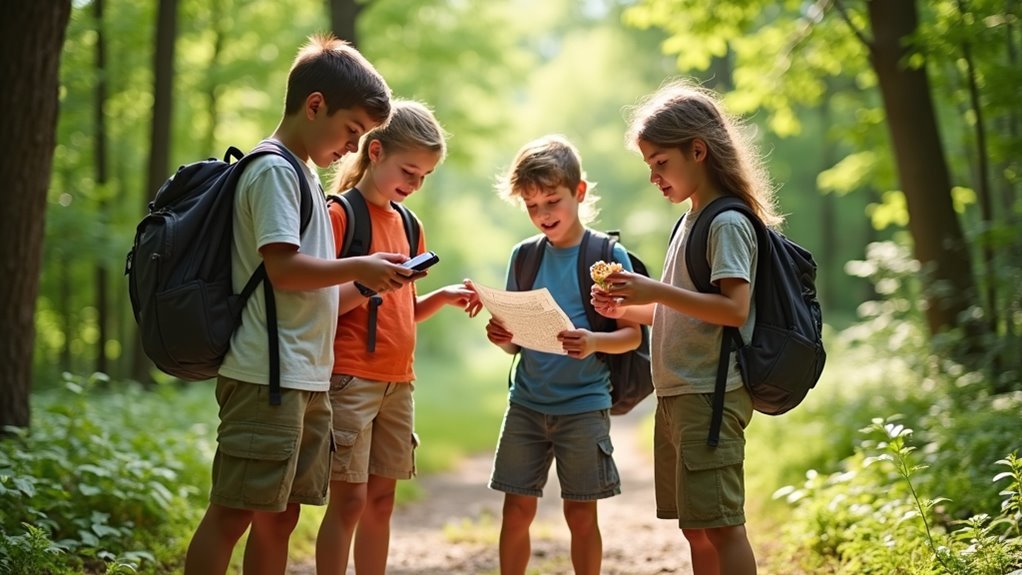Some of the links in this article may be affiliate links. If you make a purchase through these links, we may earn a small commission at no extra cost to you. Thank you.
Have you ever watched a child’s eyes light up at the promise of hidden treasure? I’ve been a geocaching enthusiast for years, and I’ve found it’s one of those rare activities that genuinely grows with your family. From toddlers clutching colorful containers in the backyard to teenagers solving multi-stage puzzles on challenging terrain, there’s a geocaching adventure perfectly suited to every age and skill level. Let me share what I’ve learned about tailoring this high-tech treasure hunt for different stages.
What Makes Geocaching Perfect for Family Adventures

Why is geocaching such a hit with families?
I think it’s because this outdoor adventure perfectly blends technology with exploration in a way that captures kids’ imagination.
With over 3 million caches worldwide, I’ve found geocaching transforms ordinary outings into exciting treasure hunts that create lasting memories.
What makes it really special as a family activity is its flexibility.
You can choose caches based on your children’s ages – from larger, easier finds for toddlers to more challenging puzzles for teens.
It’s free to start (just download the app!), and you can spend 20 minutes or several hours on your hunt.
In my experience, nothing beats watching my kids’ faces light up when they discover a hidden cache.
It sparks a genuine sense of adventure while teaching problem-solving skills in disguise.
Toddler-Friendly Geocaching: Simple Backyard Treasure Hunts
I love introducing the youngest adventurers to geocaching through specially designed backyard treasure hunts.
When I’ve tried geocaching with kids under 5, I’ve learned that simplifying is key to keeping their interest.
For an outdoor treasure hunt that works for young kids, I recommend:
- Using larger caches like colorful plastic containers that are easy to find
- Limiting the search area to your backyard where they feel comfortable
- Filling containers with fun trinkets like stickers or toy cars for trading
- Teaching basic directions like north and south as a gentle intro to navigation
The geocaching app can help you plan, but honestly, for toddlers, I’ve found that creating your own backyard hunts works better than traditional geocaching—keeps it manageable and exciting!
Preschool Geocaching: Picture Clues and Colorful Discoveries

When preschoolers outgrow those simple backyard hunts, how do you keep their geocaching adventures exciting?
I’ve found that picture-based apps are perfect for this age group.
Look for geocaches rated 1 on the difficulty scale – these are usually larger containers hidden in kid-friendly spots like playgrounds and parks.
What makes geocaching magical for preschoolers is the colorful treasure inside!
These larger caches often contain small trinkets for trading.
I always encourage my little ones to bring bright stickers or tiny toys to swap when we find a hidden cache.
The activity becomes more meaningful when they can follow visual clues on the app.
Those little pictures guide them toward the hidden treasures, and honestly, nothing beats the pride on their faces when they’ve found a cache all by themselves!
Elementary Kids: Stepping Up the Geocaching Challenge
I’ve found that elementary-aged kids really shine when they take control of the geocaching app themselves, learning to read maps and figure out north from south on their own.
You’d be amazed at how quickly they can connect with educational caches that teach them about local history or wildlife while they’re having fun hunting for treasures.
In my experience, this independence creates the perfect balance between structured learning and adventure that keeps them engaged for hours – much better than trying to drag them away from video games!
Educational Caches
Why stop at simple treasure hunts when your elementary-aged explorers are ready for more?
Educational caches transform outdoor activity into learning adventures for older kids while little kids can still participate.
When my family travels, we seek out caches that teach local history or wildlife identification—perfect for exploring new areas while avoiding poison ivy!
Here’s how to maximize these educational experiences:
- Let your child lead navigation using GPS coordinates—it’s fantastic for building real-world map skills
- Incorporate “cache in, trash out” by bringing a small bag for litter collection
- Use longer walks to build endurance while discussing the environment you’re exploring
- Turn safety talks into practical lessons about trail etiquette and nature awareness
I think these educational caches create the perfect balance between fun and learning!
Navigation Independence
How do elementary kids shift from tagging along on geocache hunts to leading their own expeditions? It’s all about gradually handing over the smart phone! I’ve found that elementary-aged explorers are ready to download the Geocaching app and follow that red line compass to find a cache within 30 feet. Let them take charge while you supervise from a few steps behind.
| Navigation Level | Distance | Skills Developed | Safety Focus |
|---|---|---|---|
| Beginner | Under 0.5 miles | Using compass | Staying on trail |
| Intermediate | 0.5-1 mile | Reading coordinates | Identifying hazards |
| Advanced | 1-2 miles | Map interpretation | Independent decisions |
| Explorer | Off beaten path | Multiple cache locations | Environmental awareness |
Tweens and Geocaching: Building Independence and Skills

I’ve noticed tweens really flourish when they’re given more responsibility in the geocaching process—they’re perfectly capable of handling advanced navigation with the app and taking charge of the entire hunt.
You can step back and watch as they develop problem-solving skills through puzzle caches and trackables, which often require them to think critically and strategically.
What’s even more exciting is encouraging them to create their own caches, where they’ll learn about selecting appropriate hiding spots and crafting clever clues that other geocachers will appreciate.
Advanced Navigation Skills
When your tween has mastered the basics of geocaching, it’s time to challenge them with more advanced navigation skills.
I’ve found that tweens love feeling like they’re on a Modern-Day Treasure hunt, especially when they’re able to find caches hidden in locations that can be quite tricky—like at the base of giant trees or inside hollowed-out tree trunks.
Here’s how to level up their skills:
- Let them tackle caches rated above 1.5 difficulty—this is where the real challenge begins
- Have them lead the navigation process completely, including interpreting terrain ratings
- Introduce them to puzzle caches and trackables that require problem-solving
- Try night caching adventures where they’ll need to apply their skills in low-visibility conditions
Creating Own Caches
After mastering the hunt, it’s time to flip the script and let your tween become the cache creator! I’ve found that tweens who’ve started geocaching really shine when designing their own geocaches hidden in familiar spots like your local park.
Encourage them to incorporate their interests—maybe a history-themed cache hidden inside a hollowed-out tree or a container reflecting their favorite hobby.
They’ll need to include small items or trinkets inside for trading, which teaches geocaching etiquette (no food or dangerous items, please!).
What I love most about this activity is watching kids develop problem-solving skills as they consider weather effects and accessibility.
They’ll use GPS to log coordinates accurately.
And honestly, the pride on their faces when someone discovers their creation is absolutely priceless.
Teen-Level Geocaching: Advanced Puzzles and Adventure Caches
Why should teens settle for basic geocaching when they can plunge into the exhilarating world of advanced puzzles and adventure caches?
As teens grow, so should their geocaching challenges!
I’ve found that teenagers absolutely thrive when tackling these more complex hunts.
For teens ready to level up their geocaching experience, I recommend:
- Puzzle caches – Decode riddles and solve brain teasers before even starting your hunt
- Adventure caches with high terrain ratings – Choose difficulty levels 3-5 for serious hiking challenges
- Trackables collection and movement – Join the global community by moving geocoins across countries
- Night caching expeditions – Grab flashlights and friends for an adrenaline-pumping evening adventure
Trust me, there’s nothing quite like watching a teen crack a complex geocaching puzzle they’ve been working on for days!
Essential Gear for Age-Appropriate Geocaching
The right geocaching gear can make all the difference between a frustrating experience and an unforgettable adventure for your kids.
First, download the free Geocaching app on your smartphone—it’s absolutely essential for finding those tiny camouflaged film canisters that toddlers get so excited about!
For little ones, I like to take small, tradable items like toy cars or stickers.
Remember the golden rule: if you take something, leave an item from the cache of equal or better value.
With older kids, especially teens, consider upgrading to a premium membership for accessing those brain-teasing puzzle caches.
Don’t forget practical stuff too—hand wipes for after digging around (trust me, you’ll need them), snacks to keep energy up, and water.
Well-prepared geocachers are happy geocachers!
Safety Considerations When Geocaching With Different Age Groups
Safety considerations should top your priority list when taking kids on geocaching adventures.
I’ve found that different age groups need specific safety approaches when hunting for that logbook to sign in locations that are important to your community.
Make sure you follow these age-specific safety tips:
- For toddlers under 5: Stick to playgrounds and short trails where containers are small enough for tiny hands but not choking hazards.
- With elementary kids: Teach them to identify poison ivy and stay on marked paths, especially when searching inside stumps/logs.
- For tweens/teens: Check terrain ratings before tackling more challenging caches, which are often protected in Ziploc bags and hidden where rain wouldn’t bother them.
- All ages: Bring hand sanitizer for touching shared items and practice “cache in, trash out” to keep nature clean.
Seasonal Geocaching Activities for Year-Round Fun
I’ve found that spring treasure hunts are perfect for kids when wildflowers pop up and trails dry out – we love searching for caches hidden among blooming meadows at places like Emmetts Gardens.
For winter solstice caching, you’ll want to bundle up the little ones and try those specially-placed holiday caches that National Trust properties often feature in their seasonal trails.
Looking at the geocaching app beforehand to filter for “kid-friendly” difficulty ratings means you can turn any season into an adventure, whether it’s tracking migratory birds in autumn or discovering natural playgrounds during summer breaks.
Spring Treasure Hunts
Spring awakens a whole new world of geocaching possibilities for families looking to combine outdoor adventures with treasure hunting fun.
With over 3 million geocaches worldwide, spring’s milder weather creates perfect conditions for introducing little ones to this hobby.
When I take my kids treasure hunting using the geocaching app, I focus on spots where rain won’t damage the caches – usually a plastic take-out container or similar waterproof container.
Geocachers usually hide caches in accessible spots during spring, perfect for toddlers!
Here’s what makes spring geocaching special:
- National Trust properties like Emmetts Gardens offer seasonal trails with blooming flora
- Larger caches hidden in natural features are easier for small hands to find
- Locations near playgrounds let kids take an item and leave one behind
- Longer daylight hours mean more time to explore found caches
Winter Solstice Caching
When the shortest day of the year arrives, geocaching transforms into a magical winter adventure that you’ll treasure with your kids.
If you’ve never tried geocaching during winter solstice, you’re missing out on quite diverse experiences at places like State Park trails where caches are ranged in size from tiny to large containers.
I took my family for their first geocache last December at Emmetts Gardens, and honestly, it’s perfect for all ages.
Toddlers can explore accessible caches while teens tackle those challenging level 5 puzzles.
The geocaching app shows over 3 million caches worldwide—many are Free Family options with educational themes about wildlife or history.
Don’t let short daylight hours stop you!
Give it a try—the National Trust properties are especially magical this time of year.
Creating Your Own Family Geocaches: A Memory-Making Project
The joy of creating your own family geocaches goes beyond just participating in the treasure hunt—it’s about crafting lasting memories together.
To become a cache owner, you’ll need to create an account first, then know about geocaching guidelines before placing your container.
When designing your family’s geocache, I recommend:
- Selecting a container that reflects your family story – anything from a small barrel to a plastic container that can contain small mementos
- Adding a logbook with your family’s introduction
- Including trade items (remember: leave something of equal or greater value)
- Choosing locations meaningful to your family
In my experience, letting kids design the container while teens manage the GPS coordinates creates the perfect division of labor.
It’s amazing how a simple hidden treasure can preserve your family adventures for years!
Frequently Asked Questions
How to Make Geocaching Fun?
I make geocaching fun by organizing night hunts with flashlights, themed events, team competitions, and creative puzzles. I blend outdoor games, share adventures on social media, and create ongoing adventure stories between finds.
What Age to Start Geocaching?
The sky’s the limit on age suitability for geocaching! I’d say toddler readiness begins around 3-5, with proper activity adaptation, parental involvement, and safety protocols matching your child’s development.
What Are the Three Main Rules of Geocaching?
I’d say our three main rules are: sign the logbook (key Logging Requirements), trade items of equal value (part of Community Standards), and hide the cache exactly as found (minimizing Environmental Impacts).
What Are Good Things to Put in a Geocache?
I’d recommend durable items like stickers, figurines, and eco-friendly swaps for cache treasures. Collectible trinkets, novelty contents, and themed swag suggestions include trackables, educational toys, and age-appropriate trinkets.